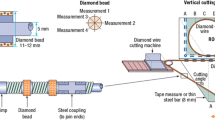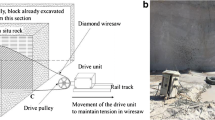Abstract
Circular diamond saw performance is affected by a variety of factors. The principal factors requiring consideration when predicting cutting rates are the type and operating features of a diamond saw and the rock characteristics. The laboratory experimental tests are carried out on three groups of rocks (16 types) cut with the help of three types of diamond disk saws with different feed rates and cutting depths at constant peripheral velocity. The quantitative determinations of a wide range of textural, mechanical, and intact properties of rocks are also made. The relationship between the specific cutting energy SE cut of the sawblade operating parameters and rock properties is established. Applying multivariable linear regression analysis, the predictive model of SE cut is developed based on the rock property data. Models verified by statistical tests prove their practical validity.
Similar content being viewed by others
REFERENCES
W. Ertingshausen, “Wear process in sawing hard stone,” Industrial Diamond Review, 45 (1985).
Y. S. Liao and S. Y. Luo, “Wear characteristics of sintered diamond composite during circular sawing, ” Wear, 157 (1992).
S. Y. Luo, “Characteristics of diamond sawblade wear in sawing,” International Journal of Machine Tools and Manufacture, 36 (1996).
S. Y. Luo, “Characteristics of diamond sawblade wear in sawing,” Journal of Materials Processing Technology, 70 (1997).
H. K. Tonshoff and J. Asche, “Verschleissverhalten von diamantwerkzeugen in der natursteinbearbeitung, ” Ind. Diamanten Rundschau, 2 (1996).
X. Xu, “Study on thermal wear of diamond segmented tools in circular sawing of granites,” Tribology Letters, 10, No.4 (2001).
H. K. Tonshoff and H. Hillmann— Apmann, “Diamond tools for wire sawing metal components,” Diamond and Related Materials, 11 (2002).
A. G. Mamalis, R. Schulze, and H. K. Tonshoff, “The slotting of blocks of hard rock with a diamond segmented circular sawblade,” Industrial Diamond Review, 39 (1979).
A. Buttner, “Diamond tools and stone,” Industrial Diamond Review, 34 (1974).
M. V. Bailey and G. J. Bullen, “Sawing in the stone and civil engineering industries,” Industrial Diamond Review, 45 (1979).
D. N. Wright and V. B. Cassapi, “Factors influencing sawabilty of stone,” Industrial Diamond Review, 45 (1985).
H. K. Tonshoff and G. Warnecke, “Research on stone sawing. In advances in ultrahard materials application technology,” Hornbeam, 1 (1982).
M. Jennings and D. Wright, “Guidelines for sawing stone,” Industrial Diamond Review, 49 (1989).
B. Brook, “Principles of diamond tool technology for sawing rock,” International Journal of Rock Mechanics and Mining Sciences, 39 (2002).
C. Y. Wang and R. Clausen, “Marble cutting with single point cutting tool and diamond segments,” International Journal of Machine Tools and Manufacture, 42 (2002).
X. Xu, Y. Li, and S. Malkin, “Forces and energy in circular sawing and grinding of granite,” Journal of Manufacturing Science and Engineering by ASME, 123 (2001).
S. Y. Luo and Y. S. Liao, “Study of behaviour of diamond saw— blade in stone processing,” Journal of Materials Processing Technology, 51 (1995).
L. Sun, J. Pan, and C. Liu, “A new approach to improve the performance of diamond sawblades,” Materials Letters, 57 (2002).
K. Webber, “Dependence of sinter metal powder and diamond in sawblade manufacture,” Industrial Diamond Review, No. 2 (2002).
X. Xu, “Friction studies on the process in circular sawing of granites,” Tribology Letters, No. 7 (1999).
H. Alehssein and M. Hood, “An application of linearised dimensional analysis to rock cutting,” International Journal of Rock Mechanics and Mining Sciences and Geomechanics, 36 (1999).
R. Simon, “Energy balance in rock drilling,” Society of Petroleum Engineering Journal, No. 3 (1963).
K. Spink, “The nature of the diamond drilling process,” Industrial Diamond Review (1972).
R. Teale, “The concept of specific energy in rock drilling,” International Journal of Rock Mechanics and Mining Sciences, No. 2 (1965).
J. Paone, D. Madson, and W. E. Bruce, “Drillability studies— laboratory percussive drilling, ” Report of Investigations, 7300, Bureau of Mines, Department of Interior, USA (1969).
M. Mellor, “Normalisation of specific energy (technical note),” International Journal of Rock Mechanics and Mining Sciences, No. 9 (1972).
C. Marx, “Evaluation of the diamond drilling process,” Industrial Diamond Review, No. 11 (1973).
H. H.A. Rabia, “Specific energy as a criterion for bit selection,” Journal of Petroleum Technology, 37 (1985).
D. N. Wrighth, “The prediction of diamond wear in sawing of stone,” Industrial Diamond Review, No. 5 (1986).
D. Miller and A. Ball, “An instrumented laboratory machine for the evolution of drill bit performance, ” Journal of the South African Institute of Mining and Metallurgy, 90, No.10 (1990).
K. Brach, D. M. Pai, E. Rattermen, and M. C. Shaw, “Grinding forces and energy,” ASME J. Eng. Ind., 110 (1988).
K. Brach, D. M. Pai, E. Rattermen, and M.C. Shaw, “Grinding swarf,” Wear, 131 (1989).
S. W. Webb and W. E. Jakson, “Analysis of blade forces and wear in diamond stone cutting,” ASME Journal Manufacturing Science Engineering, 120 (1998).
Y. Ozcelik, S. Kulaksiz, and M. C. Cetin, “Assessment of the wear of diamond beads in the cutting of different rock types by the ridge regression,” Journal of Materials Processing Technology, 127 (2002).
Testing and Examination Methods of Natural Building Stones [in Turkish], TS699, TSE Press, Ankara (1987).
Rock Characterization Testing and Monitoring Suggested Methods, ISRM, Oxford (1981).
J. Schmiazek and H., Knatz, “The influence of rock structure on the cutting velocity and pick wear of heading machines,” Gluckauf, 106 (1970).
K. Thuro, “Prediction of drillability in hard rock tunnelling by drilling and blasting,” in: Proceedings of the World Tunnel Congress “Tunnels for People,” Golser, Hinkel & Schubert (eds), Balkema, Rotterdam, Vienna (1997).
K. Thuro and R. J. Plinninger, “Roadheader excavation performance— geological and geotechnical influences. Theme 3: Rock dynamics and tectonophyisic of rock cutting and drilling,” in: Proceedings of the 9th ISRM Congress, Paris (1999).
K. Thuro and G. Spaun, “Drillability in hard rock drill and blast tunnelling,” Felsbau, 14 (1996).
J. M. Tukey, Data Analysis and Regression, Addision-Wesley Publishing Company (1997).
N. R. Drapper and H. Schmidt, Applied Regression Analysis, John Wiley and Sons, New York (1981).
J. O. Rawlings, Applied Regression Analysis: a Research Tool, Wadsworth and Brooks/Cole Advanced Books and Software (1988).
R. H. Myers, Classical and Modern Regression with Application, Second Edition, Pws-Kent Publishing Company (1990).
J. C. Braybrooke, “The state of the art of rock cuttability and rippability prediction,” Proceedings of the 5th Australian-New Zealand Conference on Geomechanics, Sydney (1988).
P. N. W. Verhoef, H. J. Van Den Bold, and Th. W. M. Vermeer, “Influence of microscopic structure on the abrasivity of rock as determined by the pin-on-disc test,” Proceedings of the 6th International Full Congress of the IAEG, Amsterdam, Balkema, Rotterdam (1990).
P. N. W. Verhoef, “Abrasivity of hawkesbury sandstone (Sydney, Australia) in relation to rock dredging, ” Quarterly Journal of Engineering Geology, 26, No.1 (1993).
Author information
Authors and Affiliations
Additional information
__________
Translated from Fiziko-Tekhnicheskie Problemy Razrabotki Poleznykh Iskopaemykh, No. 3, pp. 56–80, May–June, 2005.
Rights and permissions
About this article
Cite this article
Ersoy, A., Atici, U. Specific Energy Prediction for Circular Diamond Saw in Cutting Different Types of Rocks Using Multivariable Linear Regression Analysis. J Min Sci 41, 240–260 (2005). https://doi.org/10.1007/s10913-005-0089-x
Received:
Issue Date:
DOI: https://doi.org/10.1007/s10913-005-0089-x




